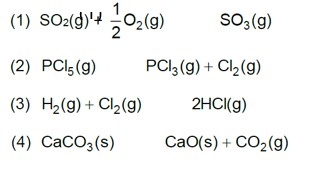7.4. Write the expression for the equilibrium constant, Kc for each of the following reactions
(i) 2NOCl (g) ?? 2NO (g) + Cl2 (g)
(ii) 2Cu(NO3)2 (s) ?? 2CuO (s) + 4NO2 (g) + O2 (g)
(iii) CH3COOC2H5 (aq) + H2O (l) ?? CH3COOH (aq) + C2H5OH (aq)
(iv) Fe3+ (aq) + 3OH– (aq) ?? Fe(OH)3(s)
(v) I2 (s) + 5F2??2IF5
7.4. Write the expression for the equilibrium constant, Kc for each of the following reactions
(i) 2NOCl (g) ?? 2NO (g) + Cl2 (g)
(ii) 2Cu(NO3)2 (s) ?? 2CuO (s) + 4NO2 (g) + O2 (g)
(iii) CH3COOC2H5 (aq) + H2O (l) ?? CH3COOH (aq) + C2H5OH (aq)
(iv) Fe3+ (aq) + 3OH– (aq) ?? Fe(OH)3(s)
(v) I2 (s) + 5F2??2IF5
Similar Questions for you
0.01 M NaOH,
M = 1 * 10-2

pOH = 2
pH = 2
Kp = Kc (RT)Dng
36 * 10–2 = Kc (0.0821 * 300)–1
Kc = 0.36 * 0.0821 * 300 = 8.86 » 9
A(g) ->B(g) + (g)
Initial moles n 0 0
Eqb. moles n(1 – a) na
total moles =
Eqb. pressure
On increasing pressure, equilibrium moves in that direction where number of gaseous moles decreases.
Taking an Exam? Selecting a College?
Get authentic answers from experts, students and alumni that you won't find anywhere else
Sign Up on ShikshaOn Shiksha, get access to
- 65k Colleges
- 1.2k Exams
- 679k Reviews
- 1800k Answers

